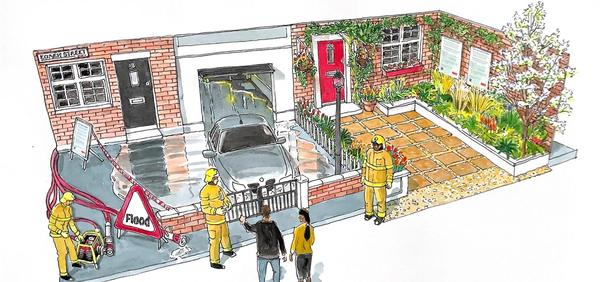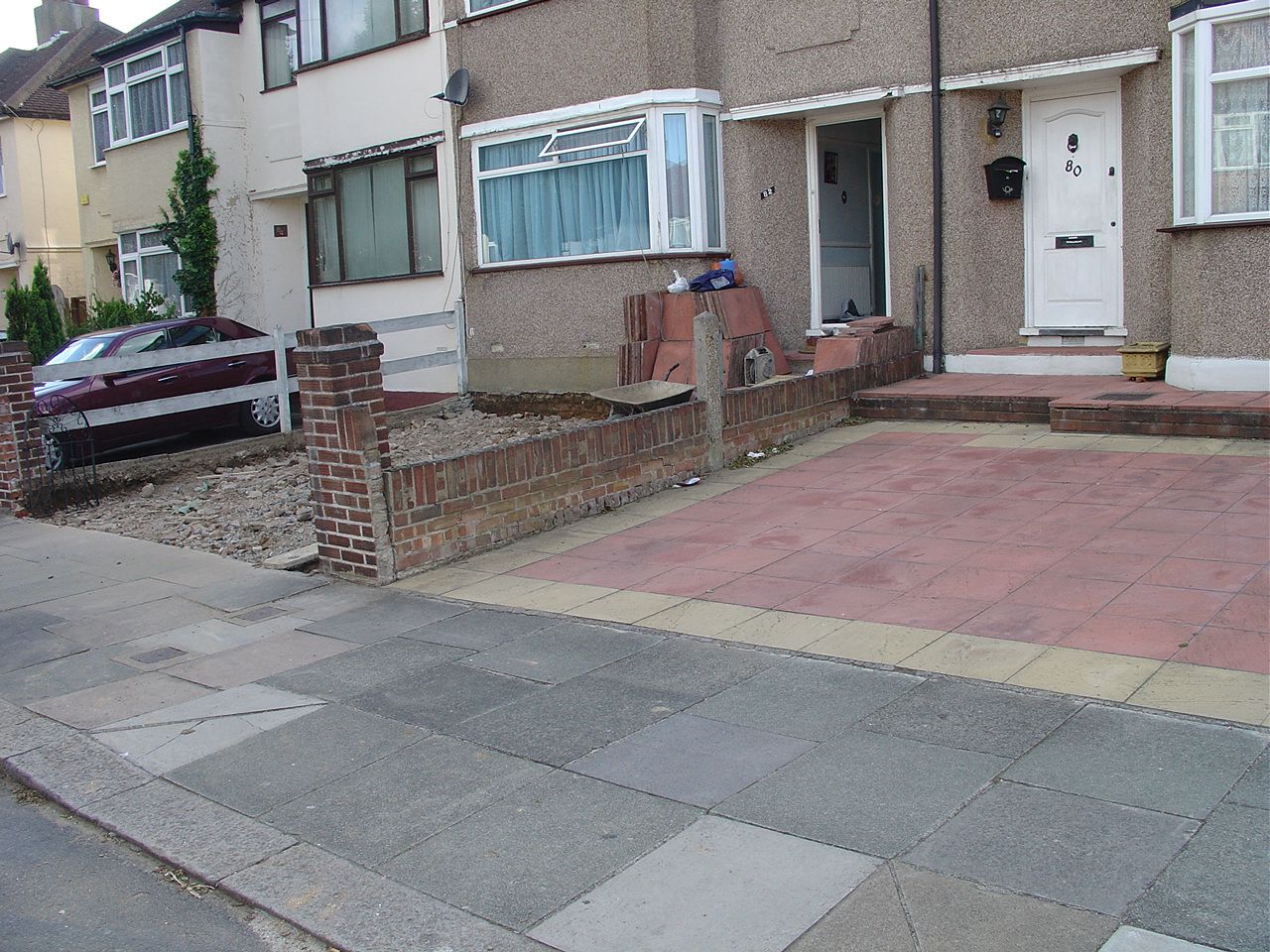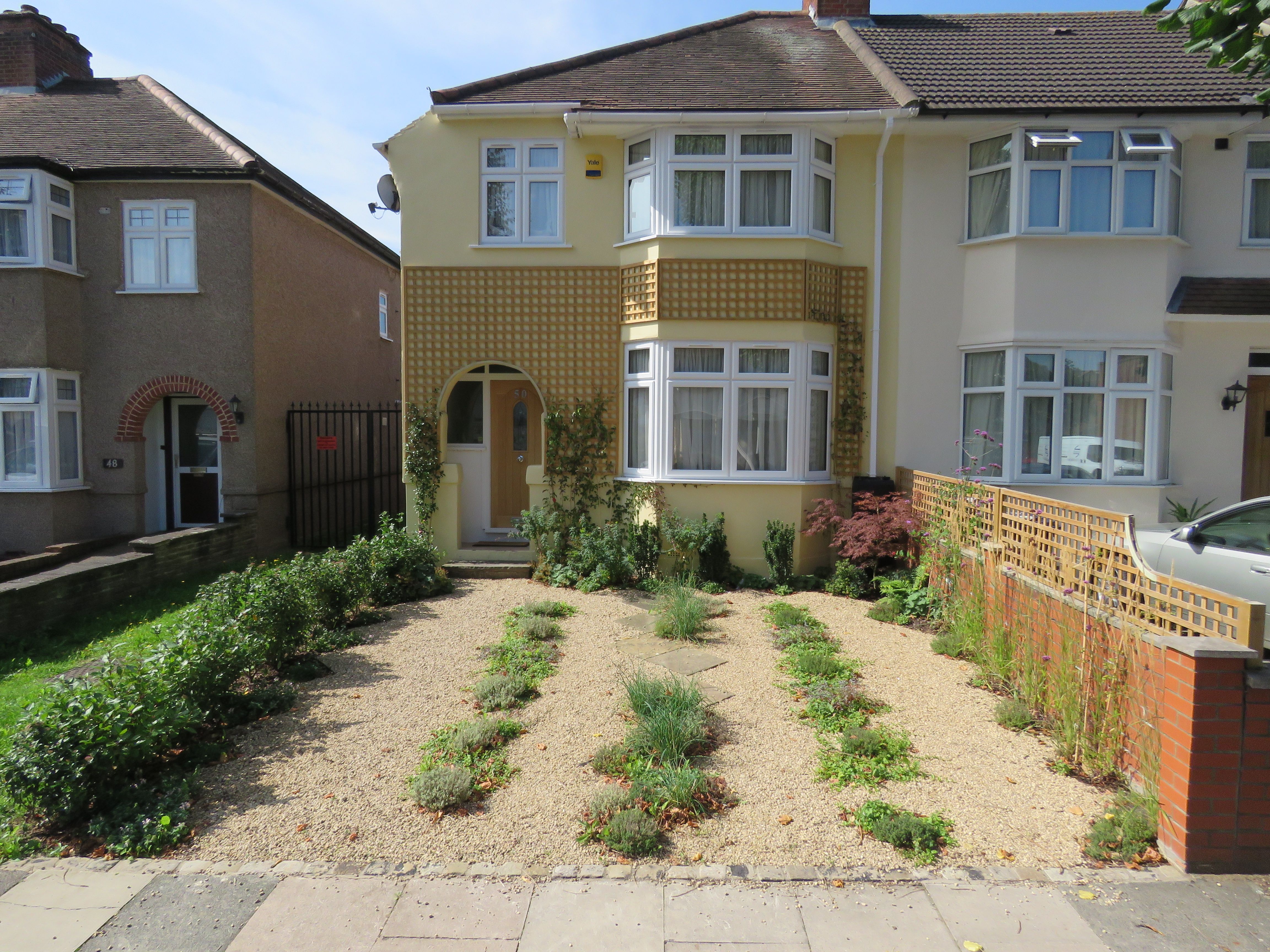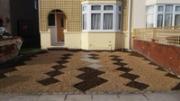
It’s great to see the London Fire Brigade highlighting how paved front garden contribute to flooding, at this year’s Chelsea Flower Show.
The Brigade is having to deal with more and more episodes of flash flooding caused by torrential downpours, and the devastation left behind. It says flooding incidents increased by 12% in London last year compared to 2020, with more than 7,000 flooding-related calls in total throughout 2021.
Paved over front gardens, even with so-called permeable paving, make flooding much worse. Heavy rain runs straight off them into road drains. These can’t cope with the sudden accumulation of water. The result is flooding and outpourings of sewerage into streets and people’s homes. In 2020 the Environment Agency (EA) estimated that 5.2 million homes and businesses in England are at risk of flooding over the next 20 years.
That’s bad enough, but paved front gardens actually cause a lot more problems as well!
They make towns and cities hotter, especially at night, leading to health problems. They don’t have any plants, so don’t absorb carbon dioxide. They make air and water pollution worse. They don’t give pollinating insects, essential for our food supplies, vital support. They contribute to subsidence and unsustainable quarrying practices. And they make entire neighbourhoods feel unattractive, even threatening.

Climate change is making all these problems worse. So paving over your front garden is the last thing you should do! Instead, keep the front garden as green as possible. Depave where you can. Choose low maintenance plants. For parking, use reinforced mesh just for where the wheels will be when the vehicle(s) are parked, and only pave the path to the front door.
Result: a front garden which is attractive, climate change resilient and won’t contribute to flooding or over-heating.

Read on for more detail:
10 climate change problems and why green front gardens help:
Problem 1 – Increased flood risk: every square metre of hard surfacing increases the amount of rain run-off. Even porous surfaces and drainage channels can’t cope with the increasingly torrential downpours that climate change is causing. This leads to flooding and outpourings of sewerage because the road drains can’t cope – we’ve already seen this in London.
- A green garden with minimal hard surfacing (just the path) absorbs rainwater and allows it to percolate slowly through the soil, so there’s no sudden influx of water into the road drains.
Problem 2 – Over-heating: hard surfaces absorb heat in the daytime and release it at night, leading to hotter nights in built-up areas. This is the “heat island effect”. It makes town and cities unhealthily hot at night, especially as summers become hotter due to climate change. It also encourages people to install air conditioning – using yet more energy.
- A green garden with minimal hard surfacing doesn’t absorb nearly so much heat. Not only that, but the plants in the garden provide shade and cool the air by evapo-transpiration. Walk down any residential street on a hot summer day – it’s like a frying pan where the front gardens are paved, but much cooler where there are trees and plants.
Problem 3 – Less carbon dioxide absorption: plants in gardens and trees in streets take up CO2 during the day for photosynthesis, but many paved front gardens have no plants at all. In addition, street trees and grass verges are sometimes removed to put in pavement crossovers (kerb drops) for parking.
- A green front garden can have plants over nearly all its surface, even if used for parking. Add boundary hedges and climbers up walls. It all helps to add to the trees and plants we’re relying on to counter climate change (by sequestering the CO2 created by burning fossil fuels).
Problem 4 – Worse air pollution: paved front gardens next to roads don’t absorb traffic-generated pollution and dust. This leads to higher levels of air pollution, especially from particulates which are known to damage to human health.
- A green front garden will absorb roadside air pollutants, particularly if it has shrubs, hedges and trees. Research shows that many hedges trap air pollutants, so a front garden with a hedge reduces air pollution, forming a barrier to help to protect the occupants of the house.
Problem 5 – Water pollution: climate change is increasing rain run-off. Run-off from paved front gardens picks up oil and heavy metals from the road surface plus pesticides, herbicides and other chemicals used in gardens and on pavements. This adds to the pollutant load and poorer water quality in local streams and rivers – in this borough the River Brent in particular.
- A green garden with hedges, plants and minimal hard surfacing (just the path) absorbs rainwater and allows it to percolate slowly through the soil. This process helps remove pollutants from ground water as it flows slowly to rivers.
Problem 6 – Loss of biodiversity: not only do paved front gardens have few or no plants and fewer street trees, the soil underneath becomes dry and sterile. The result is lack of habitat and support for all kinds of wildlife – soil dwellers, insects, birds and more – leading to measurable declines in their numbers.
- A green front garden with functioning soil and plants supports all kinds of wildlife and adds to the “green chain” of support for the web of biodiversity.
Problem 7 – Less food for pollinators: many paved front gardens have no flowering plants, so provide no nectar and pollen for pollinators. But nectar in urban areas is an important resource for pollinators (which we need to pollinate our food crops!) and gardens provide the vast majority of it, much more than parks and public spaces, verges, cemeteries etc.
- A front garden planted with a judicious mix of flowering plants and shrubs can provide nectar and pollen from March till October. Even a few pots with flowers in every front garden can make a big difference.
Problem 8 – Extensive environmental damage: the materials used for paving and concreting front gardens are dredged, quarried and processed. They are then transported over long distances – extremely long in the case of Chinese granite and the currently fashionable Indian sandstone. All this involves massive energy use and causes large-scale environmental damage.
- A green front garden uses a much more limited range of materials. Furthermore, it is largely self-maintaining – there’s no need for toxic weedkiller, pressure hoses or cleaning products, and no need to replace or repair the surface every few years.
Problem 9 – Subsidence: the soil under paved front gardens overheats and dries out. This can lead to movement of the ground and building foundations, especially in clay soils such as in London. It can be worsened by trees struggling to find water, so their roots grow further outwards and under buildings nearby.
- A green garden with minimal hard surfacing (just the path) allows rainwater to sink in, maintaining normal soil structure and hydration for plants and trees.
Problem 10 – Unattractive neighbourhoods: there’s lots of evidence that lack of green space in towns and cities create stress, mental health and societal problems. Entire streets with paved front gardens and no hedges and street trees can look dirty, unattractive and threatening, and contact with neighbours is minimised.
- Green front gardens create interest and stress-relieving green space. Plants, especially when in flower, have been shown to lift the spirits, and increase community cohesion by encouraging personal contact between neighbours.
So, paving a front garden contributes to all these major problems, each of which will be made worse by the effects of climate change. But each can be dramatically improved or completely eliminated by:
- keeping the front garden green – many plants are very low maintenance
- “depaving”: taking up most existing hard surfacing – you can do this little by little
- for parking, use reinforced mesh just for where the wheels will be when the vehicle(s) are parked
- the only hard surfacing being a path to the front door
For guidance, have a look at the Greenford restoration project on this website (https://frontgardens.nationalparkcity.org/article/a-real-life-restoration-2017/), the front garden pages of the Royal Horticultural Society (RHS) website and at “depaving” projects in the London Borough of Lambeth and elsewhere.
For more from the London Fire Brigade, see https://www.london-fire.gov.uk/news/2022-news/may/london-fire-brigade-at-chelsea-flower-show-to-show-impact-of-climate-change-and-flooding/
